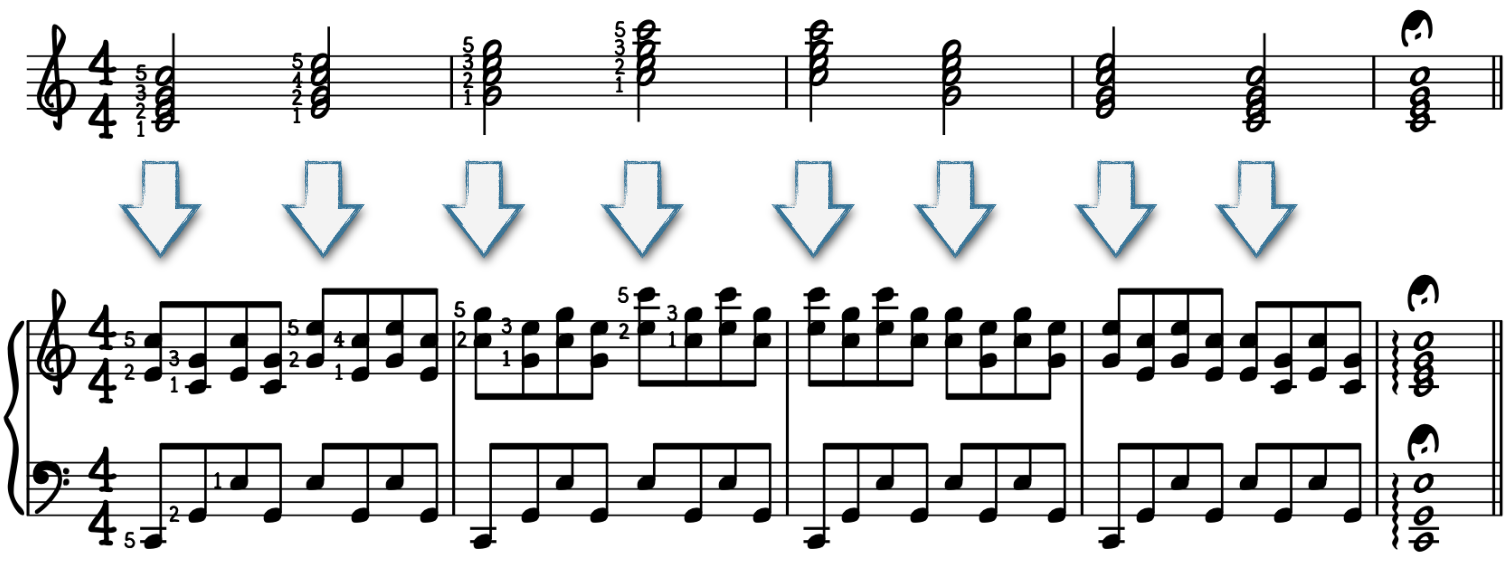How to Play Beautiful, Flowing Piano
Learning Focus
Music Style
Free Lessons
Get free weekly lessons, practice tips, and downloadable resources to your inbox!
Think of how rewarding it would be to be able to sit at the piano and improvise beautiful, flowing soundscapes. In today’s Quick Tip, Jonny May shares a fascinating arranging technique that piano students can use to create sublime, cinematic style background music. You’ll learn:
- Introduction
- Beautiful Flowing Piano Exercises
- Application: From Simply Melodies to Beautiful, Flowing Piano Textures
Introduction
In the world of musical instruments, the piano is in a class all by itself in terms of its enormous range of expressive possibilities. Indeed, the piano is capable of tender tinkling of the upper register, meditative murmurs in the middle register and surging swells in the lower register. Moreover, with the right arranging techniques, a skilled pianist can combine all of these wonderful sonic capacities together to create glorious soundscapes that rival a full orchestra. In fact, that’s exactly what you’ll learn how to do in today’s lesson!
At the heart of the beautiful, flowing piano textures that Jonny models in today’s tutorial is a unique arranging technique called interval rocking.
What is interval rocking on piano?
Interval rocking is a piano arranging technique—typically applied as 8th notes in the right hand—that creates captivating sonorities by taking a four-note voicing and dividing it into overlapping, oscillating interval pairs.
Let’s take a closer look at how the interval rocking technique works. The following example demonstrates how to take a C major triad (expressed with four notes by means of doubling a note) and dividing the chord into two pairs of overlapping intervals. By overlapping intervals, we mean that if you were to number the notes from highest to lowest, the interval rocking juxtaposes notes 1 and 3 against notes 2 and 4.

Next, let’s maximize the stream-like sonic imagery by adding a flowing broken chord accompaniment pattern in the left hand.
Add Flowing Left-Hand Accompaniment

So far, we’ve examined interval rocking examples that continue for the entire duration of a whole note and remain in a fixed hand position. However, interval rocking can also be applied to nonstationary hand positions and may last for shorter durations—such as half notes or quarter notes.
The following example illustrates nonstationary interval rocking that changes hand positions every two counts by cycling through various inversions of a C major chord.
Nonstationary Interval Rocking with Chord Inversions

As you can hear, the combination of right-hand interval rocking with a left-hand broken chord pattern results in an elegant, expressive and dynamic piano texture.
In the next section, you’ll learn how to incorporate a melodic focus to the interval rocking technique by playing flowing scalar exercises.
Beautiful Flowing Piano Exercises
In this section, we’ll play six flowing piano exercises that will allow us to apply a melodic dimension to the interval rocking technique. Moreover, we’ll practice a unique exercise for each of the major and minor diatonic chords in the key of C major. You can use the following links to jump directly to the exercise for a particular diatonic chord:
If you’re a PWJ member, you can download the lesson sheet PDF and backing tracks for this lesson from the bottom of this page after logging in with your membership. In addition, members can also easily transpose this lesson to other keys using our Smart Sheet Music.
C Major Flowing Piano Exercise (Ionian)
When using the interval rocking technique on melodies with non-harmonic tones (aka non-chord tones), we generally keep chord-tones in the inner voices (notes 2 and 3) while doubling the non-chord tone in the outer voices (notes 1 and 4). However, in some cases it will sound more pleasing to replace the inner voices with notes from a more consonant neighboring chord. For instance, since the note F clashes with the note E in a C major chord, we will actually harmonize any F’s in the melody with an F major chord. Afterward, we’ll switch right back to C major. Nevertheless, since the notes of the F chord go by so quickly, the persistent impression overall is still a static C major chord. Take a listen…

As the example above demonstrates, not only is it possible to apply interval rocking through an entire scale over a static chord, it’s also breathtaking! Nevertheless, this exercise does result in some hand shapes that are less familiar. Hence, a helpful hint when practicing these exercises is to reverse engineer them. In other words, you can reassemble each four-note chord by combining the 8th notes on each beat. Keep in mind, some of the resulting chord shapes are not triads. (For example, on beat two, the chord shape from the bottom up is D–G–C–D). Playing all four notes together for each beat will help acclimate your hand to the unique shapes that are required to play the exercise.
Now, let’s hear how interval rocking sounds over a minor chord/scale like D minor, the Ⅱ- of C major.
D Minor Flowing Piano Exercise (Dorian)
If you were thinking that inverval rocking sounds good over a major chord, just wait until you hear how it sounds over a minor chord…

Wow, what a dark and lovely sound! Surely, you can see how useful this arranging technique would be for anyone with an interest in film scoring.
Alright, next let’s apply interval rocking to the Ⅲ- of C major, which is E minor (Phrygian mode).
E Minor Flowing Piano Exercise (Phrygian)
The following flowing piano exercise demonstrates how to play an ascending and descending scalar passage from E to E over a static E minor chord in the key of C major.

Did you notice that this exercise is not a direct transposition of the exercise that we played for D minor? For instance, a direct transposition of the D minor exercise, when transposed up a whole step, would include the notes F♯ and C♯, which are not in the key of C major. Instead, we are moving modally through the key of C major. That means that the interval relationships within each exercise are unique.
If you’d like a better understanding of modes, then check out our Quick Tip on Piano Musical Modes – The Complete Guide (Int). While you don’t need to know anything about modes to play the exercises in today’s lesson, a firm understanding of musical modes will help you apply interval rocking to further playing situations.
With that said, let’s explore scalar interval rocking over the Ⅳ of C major, which is F major (Lydian mode).
F Major Flowing Piano Exercise (Lydian)
Here is how to apply interval rocking from F to F in the key of C major for a beautiful, flowing piano texture.

Great job! Let’s move on to the Ⅴ of C major, which is G major (Mixolydian mode).
G Major Flowing Piano Exercise (Mixolydian)
Here is a G major (Mixolydian) flowing piano exercise for playing a scalar melody from G to G in the key of C major.

Just a reminder, you would not use this particular example in the key of G major. If you want to play in G major, then you need to actually transpose the C Major Flowing Exercise to the key of G major. When the transposition is done correctly, it will include the note F# (unlike the example above, which features F♮’s). Remember, PWJ members can easily transpose all of this material to any key using our Smart Sheet Music.
Alright, let’s play our final flowing piano exercise for the Ⅵ- of C major, which is A minor (Aeolian mode).
A Minor Flowing Piano Exercise (Aeolian)
To apply interval rocking over an A minor chord/scale in the key of C major, we’ll play the following flowing piano exercise, which is based on the A natural minor scale, also known as A Aeolian mode.

Great job! By the way, you may be wondering, “What about the Ⅶº chord?” We certainly could create an exercise for that. However, the Ⅶº is a diminished triad and uses the Locrian mode, which contains a considerable amount dissonance. As a result, the Ⅶº occurs with much less frequency than the other six chords. Moreover, it’s uncommon to stay on a Ⅶº chord for more than a beat or two. Therefore, the six flowing exercises for major and minor chords that we’ve included represent the tonal environments that you’ll find most useful.
Congratulations, now you’re ready for the application section of today’s lesson in which you’ll transform basic melodies into gorgeous cinematic textures for piano!
Application: From Simply Melodies to Beautiful, Flowing Piano Textures
As you probably already know, most tonal music involves chord progressions that move from one chord to another. Consequently, in order to truly deploy interval rocking in our playing, we have to be able to apply it to simple melodies that extend over several different chords. Therefore, in this application section, we’ll transform simple melodies and progressions into beautiful, flowing piano atmospheres. You’ll find that the results are truly magical!
Example 1
Our first example uses a stepwise descending melody over the chord progression Ⅰ→Ⅳ→Ⅱ-→Ⅴ in C major (C→F→Dm→G). Let’s take a listen.
Example 1a – Basic Melody
Now, let’s apply what we learned in our flowing piano exercises to transform this melody. In essence, we’re just combining different fragments of the exercises from the previous section. Specifically, we’re looking at the chord symbols and then finding the corresponding section of the respective exercise that contains the notes of melody 1 shown above.
Example 1b – Beautiful, Flowing Piano Transformation

Did you catch how that works? Notice, for example, that measure 1 above is identical to measure 3 of the C Major Flowing Piano Exercise. Similarly, measure 2 above is drawn from the final measure of the F Major Flowing Piano Exercise (Lydian mode). The remaining measures are similarly arranged using fragments from the D minor (Dorian) and G major (Mixolydian) exercises.
Let’s try another melody!
Example 2
We’ve already seen how interval rocking is a powerful arranging tool for creating beautiful, flowing piano textures. However, sometimes the arranging process isn’t quite as simple as cutting and pasting from the six practice exercises in the previous section. Specifically, we haven’t yet explored how to approach melodies with passages that move more quickly than the quarter-note pulse. For instance, check out the following melody, which includes some 8th notes in addition to the longer durations we’ve already examined.
Example 2a – Basic Melody

Up until this point, each situation where we’ve applied the interval rocking technique has involved breaking up a four-note chord from a quarter note (or longer) into 8th notes. However, if a melody already contains some 8th notes (like Example 2 above), then that approach won’t work without some modification.
The best way to handle 8th-note melodic passages in the context of interval rocking is to momentarily pause from interval rocking and simply harmonize the 8th notes with consonant intervals. In particular, Jonny prefers to use 6ths, which have sweet and delicate sound. Afterward, you can resume interval rocking when you encounter longer durations again. Here is an example.
Example 2b – Beautiful, Flowing Piano Transformation

In measure 1 above, Jonny harmonizes the 8th notes E and F in the melody with diatonic 6th intervals. Hence, for the melody note E, the harmony note is G, which results in a major 6th interval. On the contrary, for the melody note F, the harmony note is A, which is a minor 6th interval. Remember, we’re just using harmony notes that come from the parent key. Therefore, we could wind up with a major 6th (9 half-steps) or a minor 6th (8 half-steps)—whichever the key signature dictates. Later, in measure 3, the 8th notes in the melody are D and E. When these notes are harmonized with diatonic 6ths, both intervals wind up being major 6ths.
Does all this talk of intervals have you a bit confused? Don’t panic. Intervals are just a fancy music term for how far apart two notes are from one another. As you might imagine, these distances are measurable. In fact, you can brush up on your comprehension of intervals in our Ear Training – Interval Crash Course (Beg–Adv).
Now, let’s turn our attention to Example 3, which will stretch our imaginations even further.
Example 3
We’ve come a long way in learning how to create beautiful, flowing piano textures with the interval rocking technique. However, so far we’ve only considered chord progressions that use diatonic chords. So what do we do if we encounter borrowed chords (chords that come from another key)? Consider, for instance, the following melody and chord progression.
Example 3a – Basic Melody

This unique chord progression featuring borrowed chords (aka modal mixture) produces a dramatic otherworldly effect that is reminiscent of adventure films or fantasy video games. This progression also illustrates the importance of understanding how to use modes. Notice, for example, that all of the chords are major chords. However, the chords E♭ major and B♭ major do not come from the key of C major. Therefore, this raises an important harmonic consideration. Should bars 2 and 3 be treated as Ionian, Lydian, or Mixolydian? What about measure 4 with that B♭ melody note over an F major chord? That seems different from our F Lydian practice exercise, right?
Let’s see how Jonny handles this challenge, and then we’ll discuss it afterward.
Example 3b – Beautiful, Flowing Piano Transformation

Working through this example demonstrates that the question of “Which mode is it?” is sometime ambiguous. For instance, in measure 2, the melody notes are the 5th and the root of E♭ major. Therefore, the interval rocking pattern would be the same whether you are thinking E♭ Lydian, E♭ Ionian, or E♭ Mixolydian. That’s because all three major modes have the same root and 5th. In fact, the differences between the major modes only becomes evident when you encounter specific non-chord tones in the melody, such as the 4th and the 7th above the root.
In measure 3, the melody contains the 3rd, 2nd and root of B♭ major. Here again, the mode is ambiguous and the interval rocking pattern is identical whether you’re thinking B♭ Lydian, B♭ Ionian, or B♭ Mixolydian.
However, in measure 4, we encounter an F major chord with the note B♭ as a passing tone in the melody. This automatically rules out F Lydian, which has a B♮. Therefore, the melody dictates either F Ionian, or F Mixolydian. Jonny’s interval rocking suggests that he is thinking of the chord as F Ionian, because if he were thinking Mixolydian, he would have harmonized the B♭ melody note with an E♭ major triad.
Ultimately, these are subtle differences. In fact, composers and arrangers have creative license to choose whatever sound colors they prefer. Nonetheless, hopefully this analysis has provided you with some different ways to think about how to approach borrowed chords.
Conclusion
Congratulations, you’ve completed today’s lesson on How to Play Beautiful, Flowing Piano. As a result, you now have brand-new dimensions to your expressive and creative capacity on the instrument!
If you enjoyed this lesson, then you’ll love the following PWJ resources:
Courses
Quick Tips
- 5 Steps to Play Magical Piano (Beg–Adv)
- Cinematic Chords—The Ultimate Guide (Beg–Adv)
- How to Play Piano Like Hans Zimmer (Int)
- How to Improvise Film Music on Piano (Int/Adv)
- Scary Piano Chords: The Halloween Progression (Int)
- 5 Sad Piano Chord Progressions (Int)
- Piano Musical Modes – The Complete Guide (Int)
Contemporary & New Age Piano Learning Tracks
Piano Foundations Learning Tracks
Thanks for learning with us today! We’ll see you next time.
Would you like to comment on this lesson?
Visit this Quick Tip on YouTube
 Writer
Writer
Michael LaDisa
Michael LaDisa graduated from the University of North Texas with a major in Music Theory & Composition. He lives in Chicago where he operates a private teaching studio and performs regularly as a solo pianist. His educational work with students has been featured on WGN-TV Evening News, Fox 32 Good Day,...
More Free Lessons
Alma Deutscher shows us how to improvise a beautiful piano piece with just 4 notes randomly chosen from a hat.
Jacob Collier just played Stride Piano unlike anything I've heard, and it's incredible! I break it down for you so you can learn his tricks.
These are the 5 core reasons why students struggle to make their chords sound interesting.
Looking for downloads?
Subscribe to a membership plan for full access to this Quick Tip's sheet music and backing tracks!
Join Us
Get instant access to this Quick Tip and other member features with a PWJ membership!
Guided Learning Tracks
View guided learning tracks for all music styles and skill levels
Progress Tracking
Complete lessons and courses as you track your learning progress
Downloadable Resources
Download Sheet Music and Backing Tracks
Community Forums
Engage with other PWJ members in our member-only community forums
Become a better piano player today. Try us out completely free for 14 days!



